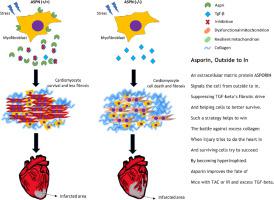Matrix Biology ( IF 4.5 ) Pub Date : 2022-04-22 , DOI: 10.1016/j.matbio.2022.04.005 Chengqun Huang 1 , Ankush Sharma 2 , Reetu Thakur 1 , Deepika Rai 1 , Madhusudhanarao Katiki 3 , Juliana de Freitas Germano 1 , Yang Song 1 , Sakshi Singh 4 , Jon Sin 5 , David Sengstock 6 , Allen M Andres 1 , Ramachandran Murali 3 , Robert M Mentzer 1 , Roberta A Gottlieb 7 , Honit Piplani 7

|
Heart failure is accompanied by adverse cardiac remodeling involving extracellular matrix (ECM). Cardiac ECM acts as a major reservoir for many proteins including growth factors, cytokines, collagens, and proteoglycans. Activated fibroblasts during cardiac injury can alter the composition and activity of these ECM proteins. Through unbiased analysis of a microarray dataset of human heart tissue comparing normal hearts (n = 135) to hearts with ischemic cardiomyopathy (n = 94), we identified Asporin (ASPN) as the top differentially regulated gene (DEG) in ischemic cardiomyopathy; its gene-ontology terms relate closely to fibrosis and cell death. ASPN is a Class I small leucine repeat protein member implicated in cancer, osteoarthritis, and periodontal ligament mineralization. However, its role in cardiac remodeling is still unknown. Here, we initially confirmed our big dataset analysis through cells, mice, and clinical atrial biopsy samples to demonstrate increased Aspn expression after pressure overload or cardiac ischemia/reperfusion injury. We tested the hypothesis that Aspn, being a TGFβ1 inhibitor, can attenuate fibrosis in mouse models of cardiac injury. We found that Aspn is released by cardiac fibroblasts and attenuates TGFβ signaling. Moreover, Aspn−/− mice displayed increased fibrosis and decreased cardiac function after pressure overload by transverse aortic constriction (TAC) in mice. In addition, Aspn protected cardiomyocytes from hypoxia/reoxygenation-induced cell death and regulated mitochondrial bioenergetics in cardiomyocytes. Increased infarct size after ischemia/reperfusion injury in Aspn−/− mice confirmed Aspn's contribution to cardiomyocyte viability. Echocardiography revealed greater reduction in left ventricular systolic function post-I/R in the Aspn−/− animals compared to wild type. Furthermore, we developed an ASPN-mimic peptide using molecular modeling and docking which when administered to mice prevented TAC-induced fibrosis and preserved heart function. The peptide also reduced infarct size after I/R in mice, demonstrating the translational potential of ASPN-based therapy. Thus, we establish the role of ASPN as a critical ECM molecule that regulates cardiac remodeling to preserve heart function.
中文翻译:

Asporin 是一种细胞外基质蛋白,是心脏重塑的有益调节剂
心力衰竭伴随着涉及细胞外基质 (ECM) 的不良心脏重塑。心脏 ECM 是许多蛋白质的主要储库,包括生长因子、细胞因子、胶原蛋白和蛋白聚糖。心脏损伤期间活化的成纤维细胞可以改变这些 ECM 蛋白的组成和活性。通过对人类心脏组织微阵列数据集的无偏分析,比较正常心脏 ( n = 135) 和患有缺血性心肌病的心脏 ( n = 94),我们确定了 Asporin ( ASPN) 作为缺血性心肌病中最重要的差异调控基因 (DEG);它的基因本体论术语与纤维化和细胞死亡密切相关。ASPN 是 I 类小亮氨酸重复蛋白成员,与癌症、骨关节炎和牙周韧带矿化有关。然而,它在心脏重塑中的作用仍然未知。在这里,我们最初通过细胞、小鼠和临床心房活检样本证实了我们的大数据集分析,以证明压力超负荷或心脏缺血/再灌注损伤后 Aspn 表达增加。我们测试了 Aspn 作为 TGFβ1 抑制剂可以减轻心脏损伤小鼠模型中的纤维化的假设。我们发现 Aspn 由心脏成纤维细胞释放并减弱 TGFβ 信号传导。此外,Aspn -/-在小鼠横向主动脉缩窄 (TAC) 压力超负荷后,小鼠表现出纤维化增加和心脏功能下降。此外,Aspn 保护心肌细胞免受缺氧/复氧诱导的细胞死亡,并调节心肌细胞中的线粒体生物能学。Aspn -/-小鼠缺血/再灌注损伤后梗塞面积增加证实了 Aspn 对心肌细胞活力的贡献。超声心动图显示Aspn中 I/R 后左心室收缩功能的更大程度降低-/-动物与野生型相比。此外,我们使用分子建模和对接开发了一种 ASPN 模拟肽,当将其用于小鼠时可预防 TAC 诱导的纤维化并保护心脏功能。该肽还减少了小鼠 I/R 后的梗塞面积,证明了基于 ASPN 的疗法的转化潜力。因此,我们确立了 ASPN 作为调节心脏重塑以保护心脏功能的关键 ECM 分子的作用。











































 京公网安备 11010802027423号
京公网安备 11010802027423号